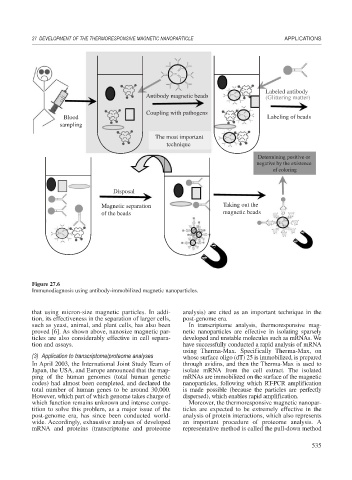Page 563 - Book Hosokawa Nanoparticle Technology Handbook
P. 563
27 DEVELOPMENT OF THE THERMORESPONSIVE MAGNETIC NANOPARTICLE APPLICATIONS
Labeled antibody
Antibody magnetic beads (Glittering matter)
Coupling with pathogens
Blood Labeling of beads
sampling
The most important
technique
Determining positive or
negative by the existence
of coloring
Disposal
Magnetic separation Taking out the
of the beads magnetic beads
Figure 27.6
Immunodiagnosis using antibody-immobilized magnetic nanoparticles.
that using micron-size magnetic particles. In addi- analysis) are cited as an important technique in the
tion, its effectiveness in the separation of larger cells, post-genome era.
such as yeast, animal, and plant cells, has also been In transcriptome analysis, thermoresponsive mag-
proved [6]. As shown above, nanosize magnetic par- netic nanoparticles are effective in isolating sparsely
ticles are also considerably effective in cell separa- developed and unstable molecules such as mRNAs. We
tion and assays. have successfully conducted a rapid analysis of mRNA
using Therma-Max. Specifically Therma-Max, on
(3) Application to transcriptome/proteome analyses whose surface oligo (dT) 25 is immobilized, is prepared
In April 2003, the International Joint Study Team of through avidins, and then the Therma-Max is used to
Japan, the USA, and Europe announced that the map- isolate mRNA from the cell extract. The isolated
ping of the human genomes (total human genetic mRNAs are immobilized on the surface of the magnetic
codes) had almost been completed, and declared the nanoparticles, following which RT-PCR amplification
total number of human genes to be around 30,000. is made possible (because the particles are perfectly
However, which part of which genome takes charge of dispersed), which enables rapid amplification.
which function remains unknown and intense compe- Moreover, the thermoresponsive magnetic nanopar-
tition to solve this problem, as a major issue of the ticles are expected to be extremely effective in the
post-genome era, has since been conducted world- analysis of protein interactions, which also represents
wide. Accordingly, exhaustive analyses of developed an important procedure of proteome analysis. A
mRNA and proteins (transcriptome and proteome representative method is called the pull-down method
535

